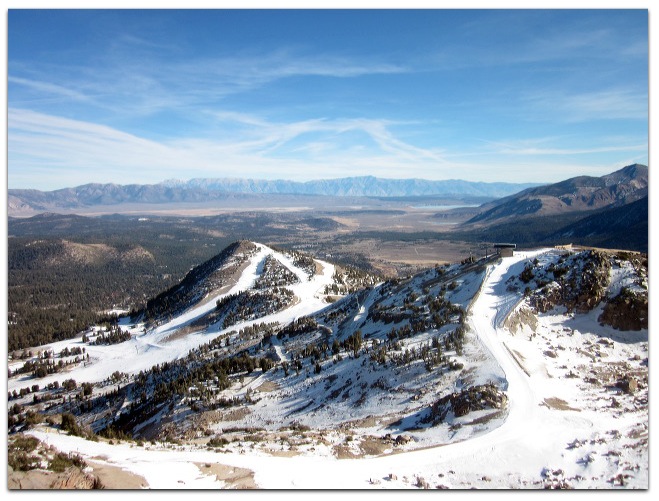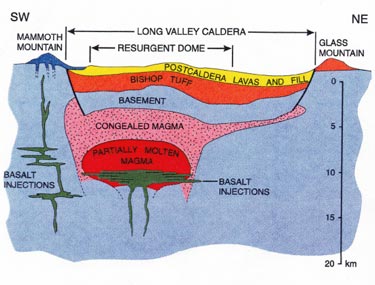
For the last three days I’ve been skiing at Mammoth Mountain, an 11,059-foot volcano built to its current shape between 110,000 and 57,000 years ago. It is still active. The mountain’s last eruption of rock and lava was about 1200 years ago, essentially in the geologic present. Lethal gasses burp out of fissures, and hot springs push steam through snow. Up to 150 tons of carbon dioxide seep out of the mountain — enough to produce a necklace of “tree kills” around its base. In 2006, three members of the Mammoth Mountain ski patrol were killed by gasses from a volcanic vent.
Mammoth overlooks the Long Valley Caldera on the east side, which is where most of the ski runs are. That’s it in the photo above, which I shot yesterday from the summit. About 760,000 years ago, a short tick before the geologic present, a supervolcano stood where Long Valley is now. It was obliterated in one of the largest explosions in the known history of the Earth. Over 150 cubic miles of material were blown out, so violently and completely that what remained was a wide deep crater. Lava flows spread for dozens of miles, while ash and debris spread from the Pacific to Kansas. The image on the right (via Wikipedia and courtesy of Roy A. Bailey, USGS Volcanologist with the USGS in Menlo Park) is a cross section of the view above.
It was obliterated in one of the largest explosions in the known history of the Earth. Over 150 cubic miles of material were blown out, so violently and completely that what remained was a wide deep crater. Lava flows spread for dozens of miles, while ash and debris spread from the Pacific to Kansas. The image on the right (via Wikipedia and courtesy of Roy A. Bailey, USGS Volcanologist with the USGS in Menlo Park) is a cross section of the view above.
To put this in perspective, Krakatoa blew 5 cubic miles into the sky. Mount St. Helens blew out less than one cubic mile. Long Valley was a VEI7 event. Only VEI8 events are bigger. Perhaps the biggest risk of a similar event is the Yellowstone caldera, which sits over a hot spot that has already produced four cataclysms exceeding the Long Valley one. Only two other events have been larger than any of those, and the largest was in Colorado. All were VEI8 events. Here’s a list of those, from Wikipedia, in decreasing order of material displaced:
- La Garita Caldera, Colorado, United States—Source of the enormous eruption of the Fish Canyon Tuff ~27.8 million years ago (~5,000 km³) This was in
- Lake Toba, Sumatra, Indonesia—~74,000 years ago (~2,800 km³). The Lake Toba eruption plunged the Earth into a volcanic winter, eradicating an estimated 60%[11][12][13][14] of the human population (although humans managed to survive even in the vicinity of the volcano[15]).
- Island Park Caldera, Huckleberry Ridge Tuff, Idaho/Wyoming, United States, Yellowstone hotspot—2.1 million years ago (2,500 km³)[8]
- Atana Ignimbrite, Pacana Caldera, northern Chile—4 million years ago (2,500 km³)[9]
- Whakamaru, Taupo Volcanic Zone, North Island, New Zealand—Whakamaru Ignimbrite/Mount Curl Tephra ~254,000 years ago (1,200–2,000 km³)[7]
- Heise volcanic field, Kilgore Tuff, Idaho, United States, Yellowstone hotspot—4.5 million years ago (1,800 km³).[10]
- Heise volcanic field, Blacktail Tuff, Idaho, United States, Yellowstone hotspot—6.6 million years ago (1,500 km³).[10]
- Lake Taupo, Taupo Volcanic Zone, North Island, New Zealand—Oruanui eruption ~26,500 years ago (~1,170 km³)
- Cerro Galan, Catamarca Province, Argentina—2.5 million years ago (1,050 km³)
- Yellowstone Caldera, Lava Creek Tuff, Wyoming, United States, Yellowstone hotspot—640,000 years ago (1,000 km³)[8]
Following that is a list of VEI7 events, including Long Valley:
- Pastos Grandes Ignimbrite, Pastos Grandes Caldera—2.9 million years ago (>820 km³)[27]
- Heise volcanic field, Walcott Tuff, Idaho, United States, Yellowstone hotspot—6.4 million years ago (750 km³).[10]
- Aso, Kyūshū, Japan—four large explosive eruptions between 300,000 to 80,000 years ago (last one >600 km³)
- Long Valley Caldera, Bishop Tuff, California, United States—~760,000 years ago (600 km³)
- Tambora, Sumbawa Island, West Nusa Tenggara, Indonesia—1815 (160 km³), the following year, 1816, became known as the “Year Without a Summer.”
- Baekdu Mountain, China/North Korea—~969 CE (96±19 km³)
- Lake Taupo, Taupo Volcanic Zone, North Island, New Zealand—Hatepe eruption ~181 CE(120 km³)[16]
- Kikai Caldera, Nansei Islands, Japan—~6,300 years ago (~4,300 BCE) (150 km³)
- Macauley Island, Kermadec Islands, New Zealand—~6,300 years ago (~4,300 BCE) (100 km³)[18][19]
- Aira Caldera, Kyūshū, Japan—~22,000 years ago (~110 km³)
- Rotoiti Ignimbrite, Taupo Volcanic Zone, North Island, New Zealand—~50,000 years ago (~240 km³)[20]
- Campi Flegrei, Naples, Italy—39,280 ± 110 years ago (500 km³)
- Reporoa Caldera, Taupo Volcanic Zone, North Island, New Zealand—230,000 years ago (~100 km³)[21]
- Mamaku Ignimbrite, Rotorua Caldera, Taupo Volcanic Zone, North Island, New Zealand—240,000 years ago (>280 km³)[22]
- Matahina Ignimbrite, Haroharo Caldera, Taupo Volcanic Zone, North Island, New Zealand—280,000 years ago (~120 km³)[23]
- Valles Caldera, New Mexico, United States—~1.15 million years ago (~600 km³)[24]
- Mangakino, Taupo Volcanic Zone, North Island, New Zealand—three eruptions from 0.97 to 1.23 million years ago (each > 300 km³)[25]
- Henry’s Fork Caldera, Mesa Falls Tuff, Idaho, United States, Yellowstone hotspot—1.3 million years ago (280 km³)[8]
- Karymshina, Kamchatka, Russia—1.78±0.02 million years ago[26]
- Bruneau-Jarbidge, Idaho, United States, Yellowstone hotspot—~10–12 million years ago (>250 km³) (responsible for the Ashfall Fossil Beds~1,600 km to the east[28])
Over the last 3/4 million years, the Long Valley Caldera has been decorated by many smaller volcanic eruptions and formations (including Mammoth), as well as by glacial advances and retreats and gradual erosion. The result looks as innocent as any other valley filled with cones and old tuff — though less innocent than Yellowstone, whose charms are mostly those of hot water.
Still, knowing the provenance of Long Valley and Mammoth gives the observer reason to pause and wonder — not only at the hugeness of Earth’s formative events, but of our species’ oblivity to them.
Bonus links:
- Supervolcanoes Won’t Destroy Earth in 2012 (livescience.com)
- U.S. seismic hazard zones awaken: Long Valley super-volcano earthquake swarm notice (theextinctionprotocol.wordpress.com)
- Is a super-volcano just 390 miles from London about to erupt? (theextinctionprotocol.wordpress.com)
- Increased seismic activity seen at dangerous Santorini caldera (theextinctionprotocol.wordpress.com)
- Long Valley Observatory (http://volcanoes.usgs.gov/lvo/)
- Volcanic Caldera Lake (gaijinmd.wordpress.com)
- Something tio watch out for – Large Icelandic volcanic eruption (amanwithaphd.wordpress.com)
- A Canarian comparison (geologygeek.wordpress.com)
- Signs of unrest at the famous Tambora Caldera in Indonesia (bigthink.com)
- What was kilaueas most violent eruption (wiki.answers.com)
- Volcanic Caldera Lake (gaijinmd.wordpress.com)
- Something tio watch out for – Large Icelandic volcanic eruption (amanwithaphd.wordpress.com)
- A Canarian comparison (geologygeek.wordpress.com)
- Signs of unrest at the famous Tambora Caldera in Indonesia (bigthink.com)
- What was kilaueas most violent eruption (wiki.answers.com)
- What was the most devastating eruption in new zealand (wiki.answers.com)
- Where are volcanoes in eastern US (wiki.answers.com)
Leave a Reply